









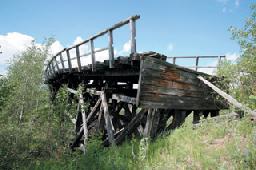 What did we know about the great Northern Railroad when we started our
expedition? It was not very much, indeed. And in order to learn more about it we,
the journalists, as well as the Moscovitan scientists and researchers, had hoped
to see a complete track system; what they had not at all expected to discover
were some isolated piles of rotten rails and green hills instead of sleepers.
For what other reason some cunning foxes had the foolish idea to rebuild this
railroad?
What did we know about the great Northern Railroad when we started our
expedition? It was not very much, indeed. And in order to learn more about it we,
the journalists, as well as the Moscovitan scientists and researchers, had hoped
to see a complete track system; what they had not at all expected to discover
were some isolated piles of rotten rails and green hills instead of sleepers.
For what other reason some cunning foxes had the foolish idea to rebuild this
railroad?
The road bed (according to the words of the local hunter V. Nechaev) was in use until 1972.
This is what documents say. Judging from what we saw with our own eyes, we can hardly believe this –although, in fact, a few isolated sections of line still exist or were rebuilt by workers of petroleum gas enterprises (Nadym – Urengoy) and local residents, respectively.
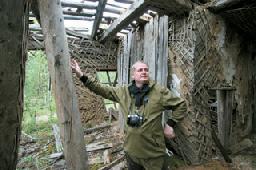 We have to admit one thing: our optimism about a revival of the construction
project along the polar circle was quickly dwindling away, when we forged ahead
into the depth of the taiga having to cope with increasing impassibility. On the
first day of our inspection of the line we moved forward at a speed of 4,2 km
per hour – by considering the fact that our Moscovitan companions were surveying
and mapping rail objects, looking for markers on the rails, making sketches and
drawings, video recordings and taking pictures.
We have to admit one thing: our optimism about a revival of the construction
project along the polar circle was quickly dwindling away, when we forged ahead
into the depth of the taiga having to cope with increasing impassibility. On the
first day of our inspection of the line we moved forward at a speed of 4,2 km
per hour – by considering the fact that our Moscovitan companions were surveying
and mapping rail objects, looking for markers on the rails, making sketches and
drawings, video recordings and taking pictures.
We were also infected by this railroader-researcher game. Vladimir Pavlovskiy was the best with regard to the number of unpayable finds. He was, however, deeply grieved that he did not stumble across any rails from the year 1905 (the very year, when our newspaper was edited for the first time). Although the rails originated from pre-revolutionary times (starting with the year 1901), we saw rails of domestic, as well as foreign production – all scattered to the four winds. As likely as not, they had been shuttled in small lots from demolished track sections to this place and then hastily layed by hand in different lenghths and breadths.
We discovered just one single undamaged track, which passed fairly close by a sand pit. The material used to heap up the road bed was, as a general rule, dusty sand. In the eastern area, which we explored, the sand as rather coarse than dusty – hence of superior quality.
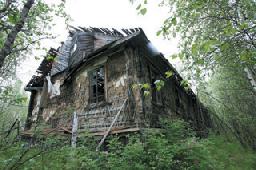 In order to shorten distances (less than 3 kilometers), they had people work for
the stone and sand pits near the roadline. Loading was often done by hand.
In order to shorten distances (less than 3 kilometers), they had people work for
the stone and sand pits near the roadline. Loading was often done by hand.
In one of the pits we stayed for along time. The researchers, in the true sense of the word, “dug up” the whole place with their eyes. And – they found aluminium mugs with numbers on them. These exhibits, without any doubt, decorate the lectern of some university auditorium today, thus putting the listeners into the right mood for their studies … in quite a lyrical way.
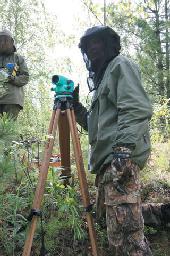 In the 1940s and 1950s there was only little romance. Every five kilometers
along the railroad there was a camp. About thirty altogether. The wooden
barracks looked all the same. The staff members of the camp authorities lived
under slightly better conditions; this might be the reason for why their houses
remained in good repair. On the walls you can still see the faded wall papers –
fixed by nails. For they would not transport glue or paste to such remote
places.
In the 1940s and 1950s there was only little romance. Every five kilometers
along the railroad there was a camp. About thirty altogether. The wooden
barracks looked all the same. The staff members of the camp authorities lived
under slightly better conditions; this might be the reason for why their houses
remained in good repair. On the walls you can still see the faded wall papers –
fixed by nails. For they would not transport glue or paste to such remote
places.
By the way, prisoners here were not only assigned “black” (dirty; translator’s note) to.They were also appointed controlers, foremen, group or brigade leaders and even supervisors of bigger construction projects. Those, who had already been released from permanent escort, were working for the offices as project managers. However, the labour productivity of these weakened, tormented people was much lower than the productivity of free workers!
 The completion of objects and railroad sections within the time stated – 120 km
per year – would not have been realized without the labour of the great number
of prisoners deported to this region. According to some statements about 200.000
individuals were being kept in camps situated along the railroad. Only after
Stalin’s death they had a slight hope to be released. However, the leader only
gave them back their looked-for freedom very slowly and hesitatingly – for
having done heroic labour. We suppose that a machine operator, who came here by
ship on the Yenisey as a pioneer, could count on such an act of generosity from
the part of the government. Since any escape from these remote places was
futile, there were practically no bars in front of the barrack windows.
The completion of objects and railroad sections within the time stated – 120 km
per year – would not have been realized without the labour of the great number
of prisoners deported to this region. According to some statements about 200.000
individuals were being kept in camps situated along the railroad. Only after
Stalin’s death they had a slight hope to be released. However, the leader only
gave them back their looked-for freedom very slowly and hesitatingly – for
having done heroic labour. We suppose that a machine operator, who came here by
ship on the Yenisey as a pioneer, could count on such an act of generosity from
the part of the government. Since any escape from these remote places was
futile, there were practically no bars in front of the barrack windows.
Even the railroad itself seems to lead to nowhere. And it just appears from nowhere, as well. We, the participants of the exhibition got involved in this phenomenon on the second day of our trip along the Great Roadline. On the opposite side of the Makovskaya River clear outlines of the railway sleepers seemed to extend to several hundred meters. And then- nothing but swampland and windthrow (trees uprotted by wind; Translator’s note). With each step the area became more an more impassable. The very first obstacle that crossed our way was a little bridge, which was in a really miserable state. Our editor jokingly suggested to burn it down on our way back, so that nobody, heaven forbid, would meet with an accident. The rotten, treacherous planks were cracking below our feet, ready to cave in and throw us, the daredevils, into the creek; but they resisted our weight.
 We continuously hit little creeks. Damka, an Eskimo dog, was a reliable
bodyguard. She was pleased as a little child about the cool freshness of the
water and the possibility to quench her thirst; and we enjoyed drinking the warm
Khakassian,mineral containing spring water, too.
We continuously hit little creeks. Damka, an Eskimo dog, was a reliable
bodyguard. She was pleased as a little child about the cool freshness of the
water and the possibility to quench her thirst; and we enjoyed drinking the warm
Khakassian,mineral containing spring water, too.
At that time the water of the creeks was piped through a pipe system made of planks and logs – a unique mechanism of the past century, even though these wooden constructions were not made for ever; they were hammered together by simplest means. Surprisingly, they have resisted for more than half a century, although they have neither undergone any repair nor renewal since then. Even non-experts quickly notice the caved-in ground – a result of permanent frost and the very distinct continental climate. The tubes protrude from the embankment, making you hardly believe that once there was railroad in this very place. And nowadays common juniper is growing right on top of the railway sleepers, you can see the reddish, shimmering leaves of lingonberries; young birch trees , fir trees and purple willows are growing everywhere. On this side of the Makovskaya River almost all sleepers were removed and apparently transported away in parts. It would be interesting to learn where they took them to? In Turukhansk nobody is in need of any such benefaction; and hauling them all the way up to Krasnoyarsk is not only utterly uncomfortable but very expensive, as well.
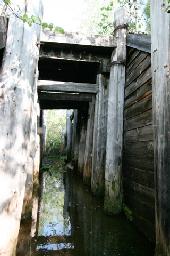 Anyway,there is evicence on the fact that tracks from the section betwenn Igarka
and Turukhansk were entried as property of the Norilsk Mining and Metallurgy
Combine in the 1960s.
Anyway,there is evicence on the fact that tracks from the section betwenn Igarka
and Turukhansk were entried as property of the Norilsk Mining and Metallurgy
Combine in the 1960s.
According to the rough estimates of our scientists we were to reach Turukhan Station on the second day. We tried to orientate ourselves by bridges and the chimney of former camp buildings. We had already passed all points marked on our map, nonetheless we were unable to find the railway station. Our group leader, Andrei Zaitsev, let himself be carried away by the assumption that nothing had been left of the place and that it would be more reasonable to return. Only some time later it suddenly dawned on us: just 4 or 5 kilometers had separated us from the little station. However,we decided not to go there once again. What a portent! And the people wholive in the taiga do believe in omen – inconditionally.
But when you visit the taiga for the first time, you willnot notice the imminent danger. For good reason the head of Turukhansk district town assigned us an experienced hunter as companion: Viktor Nechaev. Viktor, armed with a carbine, and Damka accompanied us during the whole expedition. He turned out to be a reticent and, in someway, scowling travel companion, but, as we then found out, his behaviour was completely justified.
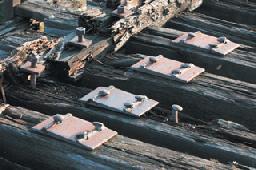 I do remember how Vladimir Pavlovskiy insisted on learning from him who had left
those huge, distinctive footprints on the forest track. Only when we had almost
reached Turukhansk he told us that all the time we had been walking on a path,
which was frequented by wild animals, too. It had been beaten by elks,
reindeers, maybe wild pigs and, primarily, by the lords of the taiga – bears.
When the taiga lay behind us and we were on our way back to the cutter, Viktor
noticed that a curious bear was following us, just to observe if we might do any
mischief within its territory.
I do remember how Vladimir Pavlovskiy insisted on learning from him who had left
those huge, distinctive footprints on the forest track. Only when we had almost
reached Turukhansk he told us that all the time we had been walking on a path,
which was frequented by wild animals, too. It had been beaten by elks,
reindeers, maybe wild pigs and, primarily, by the lords of the taiga – bears.
When the taiga lay behind us and we were on our way back to the cutter, Viktor
noticed that a curious bear was following us, just to observe if we might do any
mischief within its territory.
(To be continued….)
Tatyana Makogonova
Photos by Aleksander KUZNETSOV
“Krasnoyarsk Labourer”, 30.07.2005